Having looked at DC’s most renowned leftist vigilante last week, today Gotham Calling turns to Marvel’s notorious right-wing anti-hero, the Punisher. While he is usually quite a one-note guy (wears a skull on his chest, kills criminals, that’s it), what makes this character so fascinating is how variedly writers have approached him throughout his long, mass murderous career. Since the Punisher’s debut in 1974, depictions of his exploits have ranged from escapist guilty pleasure to thoughtful exploration of violence to downright disturbing wish-fulfilment!
Because this is a Gotham-centric blog, let me begin by pointing out the obvious: The Punisher is a very different character from Batman. Whereas Bruce Wayne saw his two parents killed when he was a kid, Frank Castle (formerly Castiglione) saw his two children and wife killed (during a picnic in Central Park) when he was an adult – in fact, by then he was already a veteran of the Vietnam War. This is important, because Bruce went on to study and train himself in order to become someone who prevents crime, especially murder (hence the ‘no killing’ rule), while Frank drew on his prior military combat experience to become someone who punishes criminals by committing as much (targeted) murder as possible.
The result is, typically, two different types of comics starring these characters. One is about a billionaire in an imaginary town with a super-theatrical alter ego who matches wits with tragic (recurring) villains, with the climax often involving the Caped Crusader preventing some ultimate evil scheme. The other is about a Manhattan-based, no-nonsense, gun-toting vet who methodically kills his way up the food chain, with the climax involving the Punisher finally killing that story’s most spiteful baddie in a particularly amusing or satisfying way.
 Deadly Knights
Deadly Knights
You can argue that, politically, both protagonists are conservative in the sense that they seek to compensate for the flaws of a presumably too liberal criminal justice system, disregarding civil rights in order to more effectively investigate (through torture, hacking, unsupervised B&E) and/or punish (execution without due process). That said, there’s an anti-death penalty message at the core of Batman comics, in contrast to the Punisher’s bloodthirsty eye-for-an-eye logic. Likewise, the former tend to have a pro-gun-control slant, with the hero going out of his way not to use guns and to prevent illegal arms traffic, while Punisher comics reflect more of a ‘Guns don’t kill people, people kill people’ attitude, not to mention ‘The best way to stop a bad guy with a gun is a good guy with a gun.’
The two franchises also feel different because they originate in distinct genre traditions. While Batman goes back to noirish pulp, the Punisher emanates from ‘70s exploitation. More specifically, his creator, Gerry Conway, modelled Frank Castle on the lead of The Executioner series of books about a former Green Beret who wages a war against organized crime to avenge his family (but, as far as I know, does not wear a skull on his chest).
The Punisher made his debut in The Amazing Spider-Man #129. His early stories were mostly guest appearances in popular titles. Frank’s black & white morality and extreme methods would make him either the antagonist or at least a revealing contrast vis-à-vis the main star (most notably in Frank Miller’s classic Daredevil run). This means that, regardless of the character’s roots in Nixon-era vigilante fantasies, the Punisher’s initial decade-worth of comics didn’t exactly look like Dirty Harry or Death Wish, since he was constantly clashing with a dude with arachnid powers or with a shield-carrying captain dressed with an American flag…
He has continued to regularly guest-star in other heroes’ adventures to this day. Writers like Matt Fraction and Rick Remender had a lot fun turning even the Punisher’s own series into straight-up superhero comics, treating Frank Castle as just another madcap aspect of the madcap Marvel Universe.
But that was not the spirit of the Punisher’s first solo series, the 1986 mini later collected as Circle of Blood:
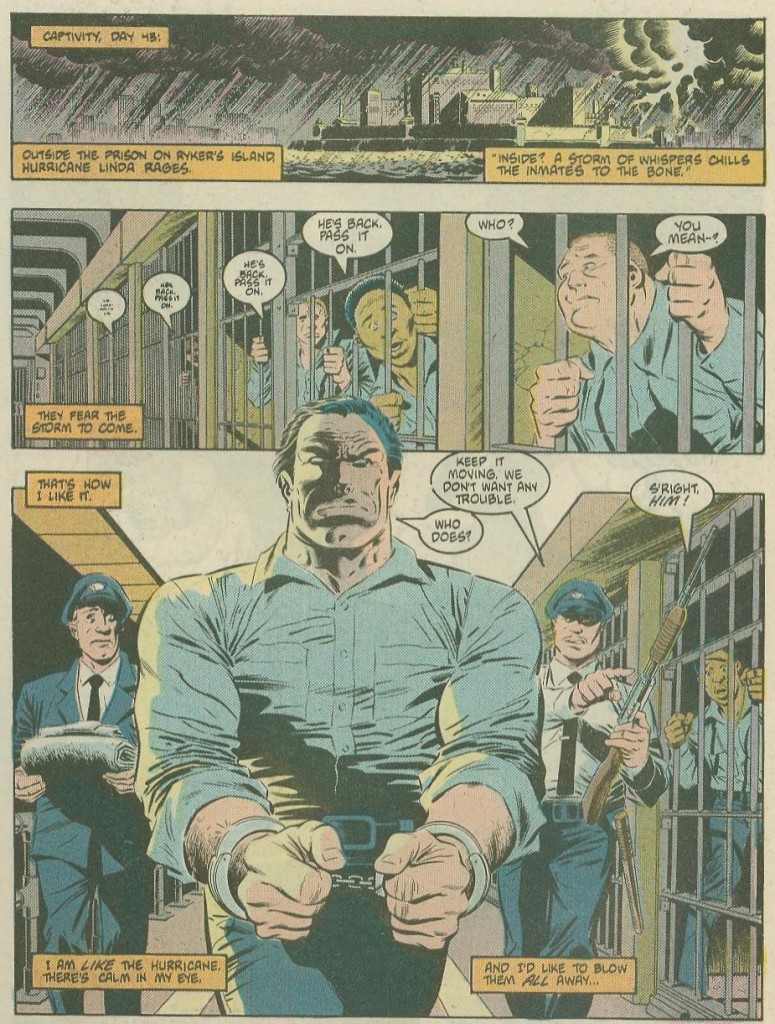 The Punisher #1
The Punisher #1
Written by Steven Grant and drawn by Mike Zeck (the duo who did the ultra-hardboiled Batman two-parter ‘Criminals’), this was one badass yarn, from the opening prison sequence all the way down to the The Italian Job-esque finale. There were no masks around and just a few brief mentions of events and characters from other Marvel comics (including Wilson Fisk and Ben Urich). As brutal as the tone was, though, the plot was still a bit hokey, as it ultimately involved Frank going up against a citizens’ organization that brainwashed criminals in order to make them part of a private squad of punishers!
Grant and Zeck outdid themselves with Return to Big Nothing, one of the most hard-hitting Punisher stories of all time. This original graphic novel dug under the skin of the character, who went after a smuggling ring and ran into an old rival from his Vietnam days. The book provided powerful glimpses into the Punisher’s damaged psyche, as he referred to his past self in the third person (‘Frank Castle knew him.’) and fantasized about his dead wife, Maria, while sleeping with a prostitute:
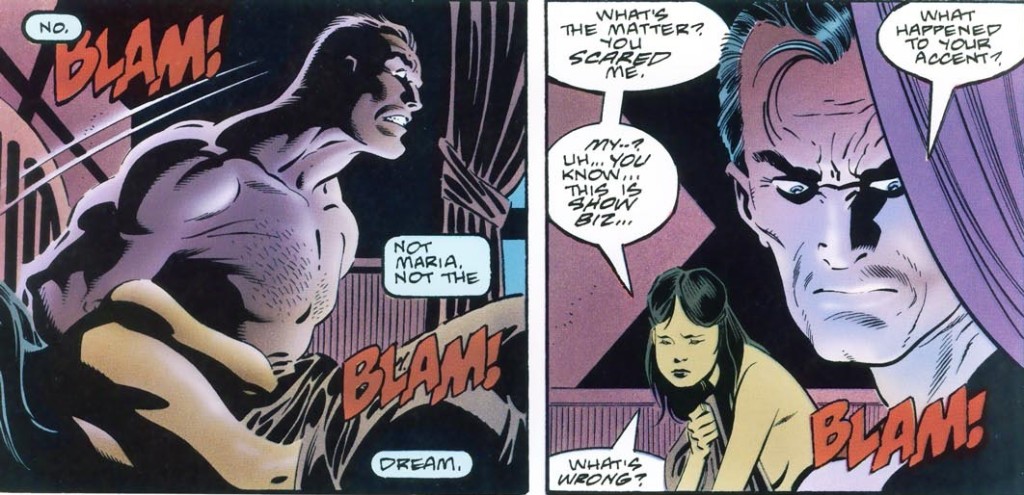 Return to Big Nothing
Return to Big Nothing
Return to Big Nothing is one of those Punisher books that also works as just a gritty, well-crafted crime comic in its own right. Another example from this time is Assassin’s Guild, written by Jo Duffy and illustrated by Jorge Zaffino. Duffy, who also helped out with Circle of Blood, is perhaps best known to Bat-fans for her ‘90s run in Catwoman (and to Marvel fans for her run in Power Man and Iron Fist, which was the most amusing combination of Blaxploitation and Kung Fu since Cleopatra Jones and the Casino of Gold).
The most prolific Punisher writer of the late-eighties/early-nineties, Mike Baron, had more of a popcorn entertainment approach to the character. Baron, who among other things launched The Punisher ongoing series that would last for over one hundred issues, wrote big, brash escapades full of explosive action. His Frank Castle wasn’t a grim Eastwood or Bronson but more the gung-ho Schwarzenegger/Stallone of Commando, True Lies, Rambo, and Tango & Cash.
Better yet, Mike Baron’s comics, written through a coked-up haze, didn’t feel like blockbusters as much as like sleazy post-grindhouse, straight-to-VHS B-movies gleefully ripping off box office hits. The Punisher used every conceivable tactic of urban guerrilla and, likewise, suffered all kinds of torture before escaping with the help of a ‘diamond-tipped manicure’ that enabled him to cut through ropes with ultra-sharp fake fingernails. Enacting id-driven revenge scenarios, Frank slaughtered enemies straight from the headlines – in the first ten issues of The Punisher (still quite taut, before things got really over-the-top), he took his war to ghetto drug dealers, a Bolivian cartel, Missouri white supremacists, a cult led by a proto-Charles Manson, Arab terrorists, and Wall Street inside traders.
Baron and other writers of that era tended to depict the Punisher in a sympathetic light. Although he was clearly a psycho, for the most part this version of the character didn’t come across as necessarily more unbalanced than your average action movie hero. Apart from the size of the body count, he could’ve been called Martin ‘Lethal Weapon’ Riggs or Marion ‘Cobra’ Cobretti. Frank Castle was just one tough bastard who had declared war on criminals and, true to his marine background, was willing to kill them in cold blood, but he hadn’t completely lost his humanity. He could blend in and be charming with the ladies. He even had a buddy, Microchip, a hacker who regularly helped him out – with their military banter and resourceful libertarian justice, they were like a two-men A-Team.
What’s more, true to the character’s ‘Men’s adventure’ origins, the Punisher became a veritable globetrotter, going wherever he felt righteous killing needed to be dispensed. This is him in Marvel’s version of the Middle East, trying to blend in by wearing a moustache:
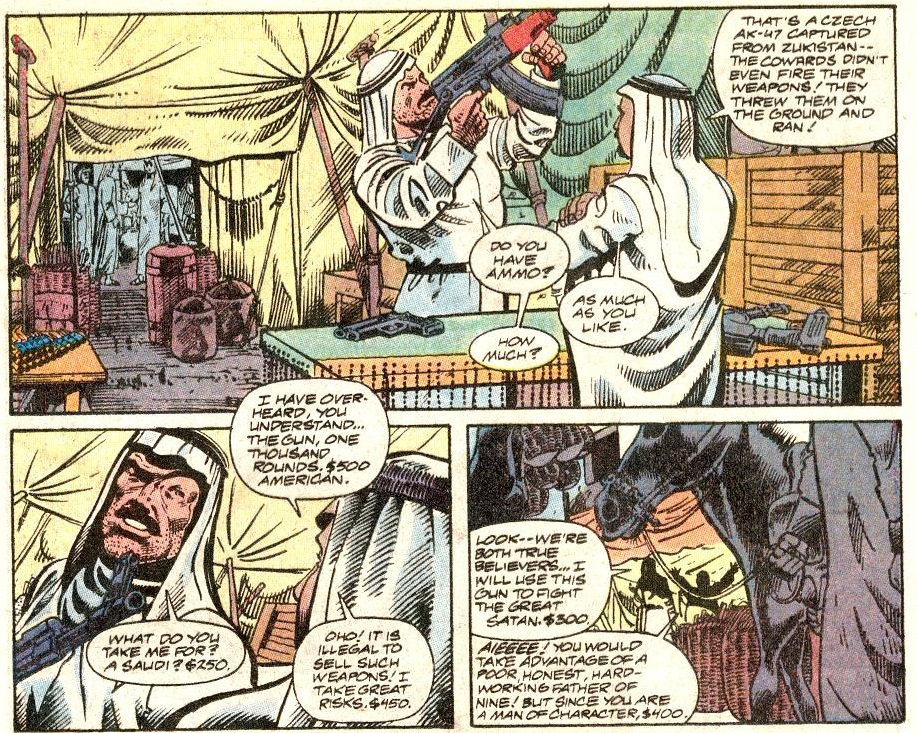 The Punisher (v2) #47
The Punisher (v2) #47
All this traveling meant that the Punisher also got involved in international politics. It helped that Microchip was a self-professed Zionist and that one of the few recurring villains was Saracen, an Arab mercenary.
Saracen played a role in memorable storylines, including ‘The Sicilian Saga’ (which had an amusing follow-up titled ‘Let Them Eat Cake’), ‘The Brattle Gun,’ and ‘The Kamchatkan Konspiracy.’ No holds were barred in these comics, particularly in the latter one, which featured a proto-Jane Fonda, the Crips, the Bloods, a disintegrating Soviet Union, and a radical environmentalist group called HOP – Humans Off Planet. It also contained a curious scene in which Saracen reacted to his depiction as an Orientalized stereotype:
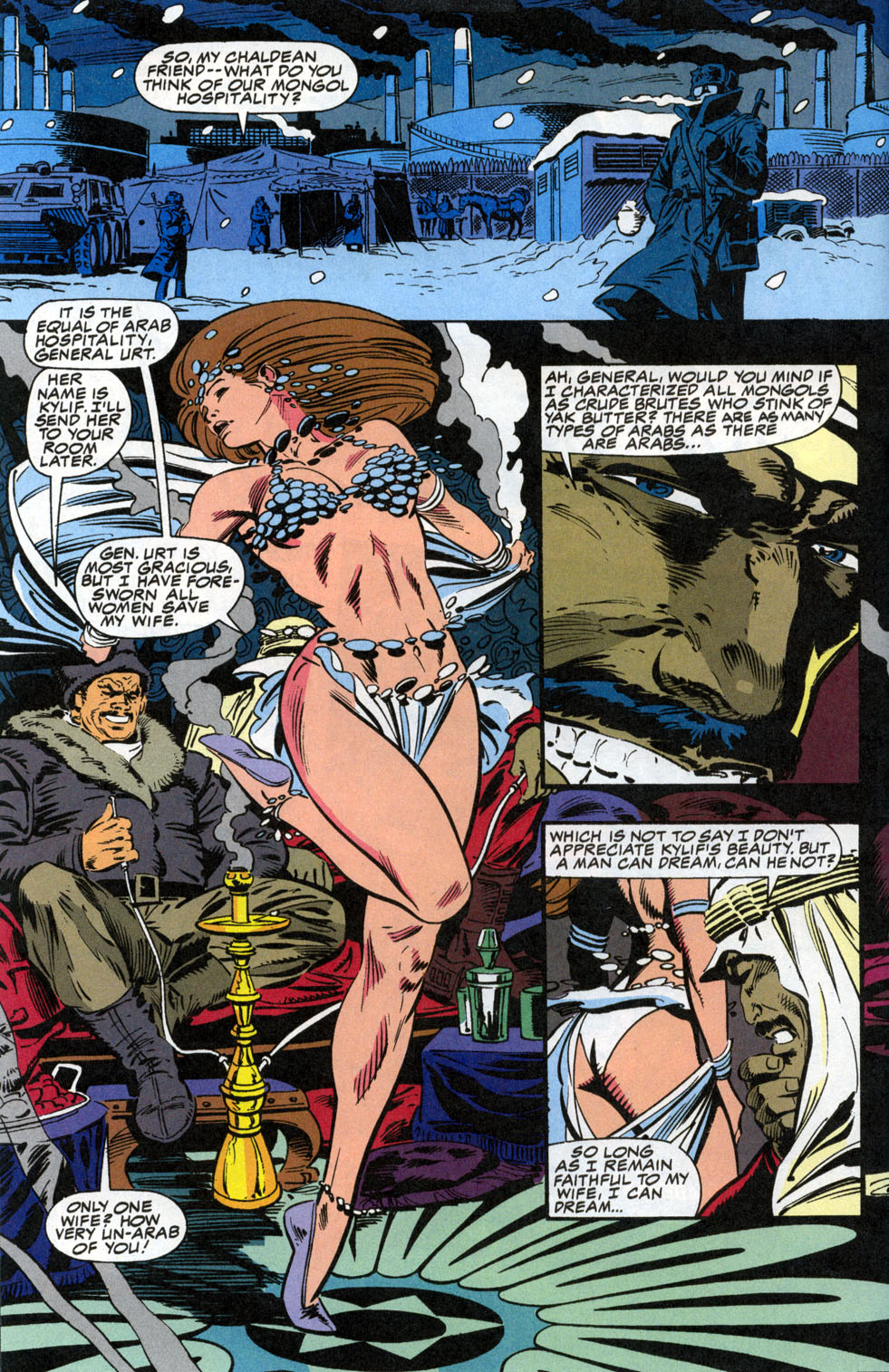 The Punisher War Journal #33
The Punisher War Journal #33
Me, I’m a sucker for short, kick’em-and-leave’em stories like ‘Border Run,’ which operate on the premise of just dropping the Punisher on a hostile location, with a clear objective, and watching him improvise while out of his element for 22 pages.
The master of this type of self-contained single issues was Chuck Dixon. With his clipped dialogue and dynamic storytelling, Dixon wrote a bunch of tight variations of Die Hard starring the Punisher – in a taxi cab (‘One Way Fare’), in the snow (‘Death Below Zero’), in the supermarket (‘The Big Check-Out’), in a train (‘Armageddon Express’), or while falling from a goddamn airplane (‘Terminal Velocity’).
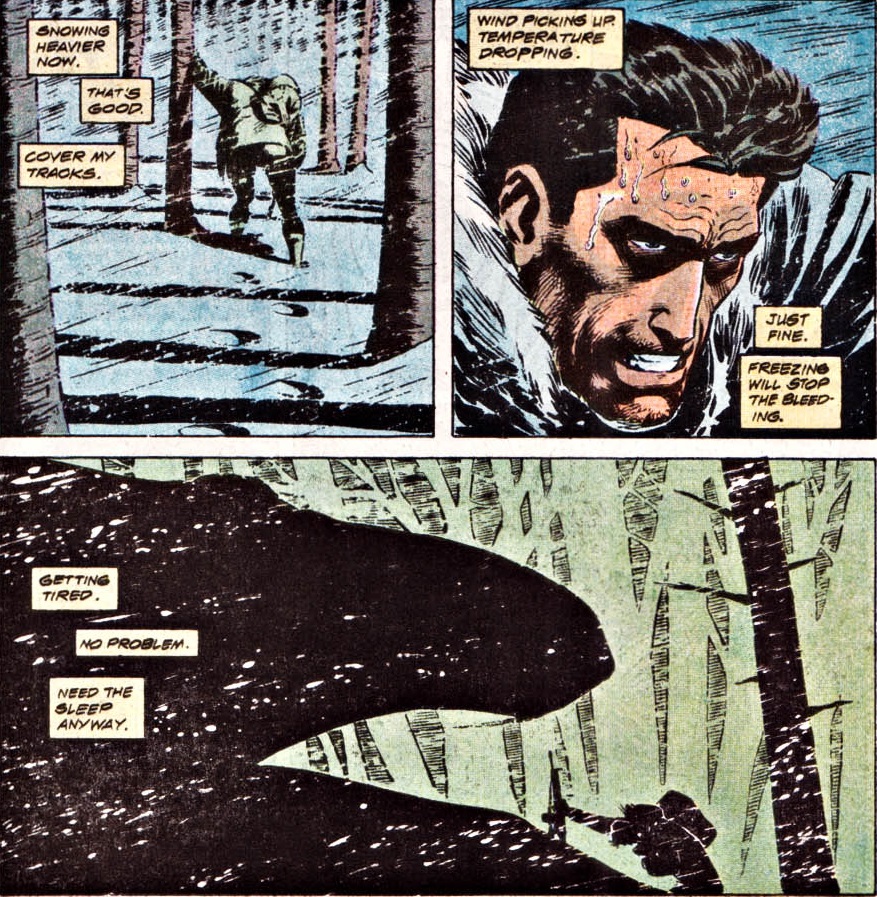 The Punisher (v2) #49
The Punisher (v2) #49
Chuck Dixon also got to do a Frank-Castle-in-Vietnam flashback for Marvel’s surprisingly long-running Vietnam War comic The ‘Nam (issues #67-69). Frank had shown up in the series before (issues #52-53), but letting Dixon have a go at it just seems like a logical option since he’s such a great author of war tales (check out his Team Zero or, if you like a bit more pizzaz to go with your military fiction, his prose novels about time-travelling Army Rangers, Bad Times, starting with ‘Cannibal Gold’). Dixon later brought back The ‘Nam character Ice Phillips in the neat two-parter ‘Heart of Ice/Heart of Stone.’
Moreover, Dixon could write epic adventure better than anyone else, throwing the Punisher into large-scale, twist-filled missions in the Caribbean and Eastern Europe. Kingdom Gone (art by Jorge Zaffino), River of Blood (art by Joe Kubert), and Barbarian with a Gun (art by John Buscema) remain hands-down some of the best Punisher comics ever.

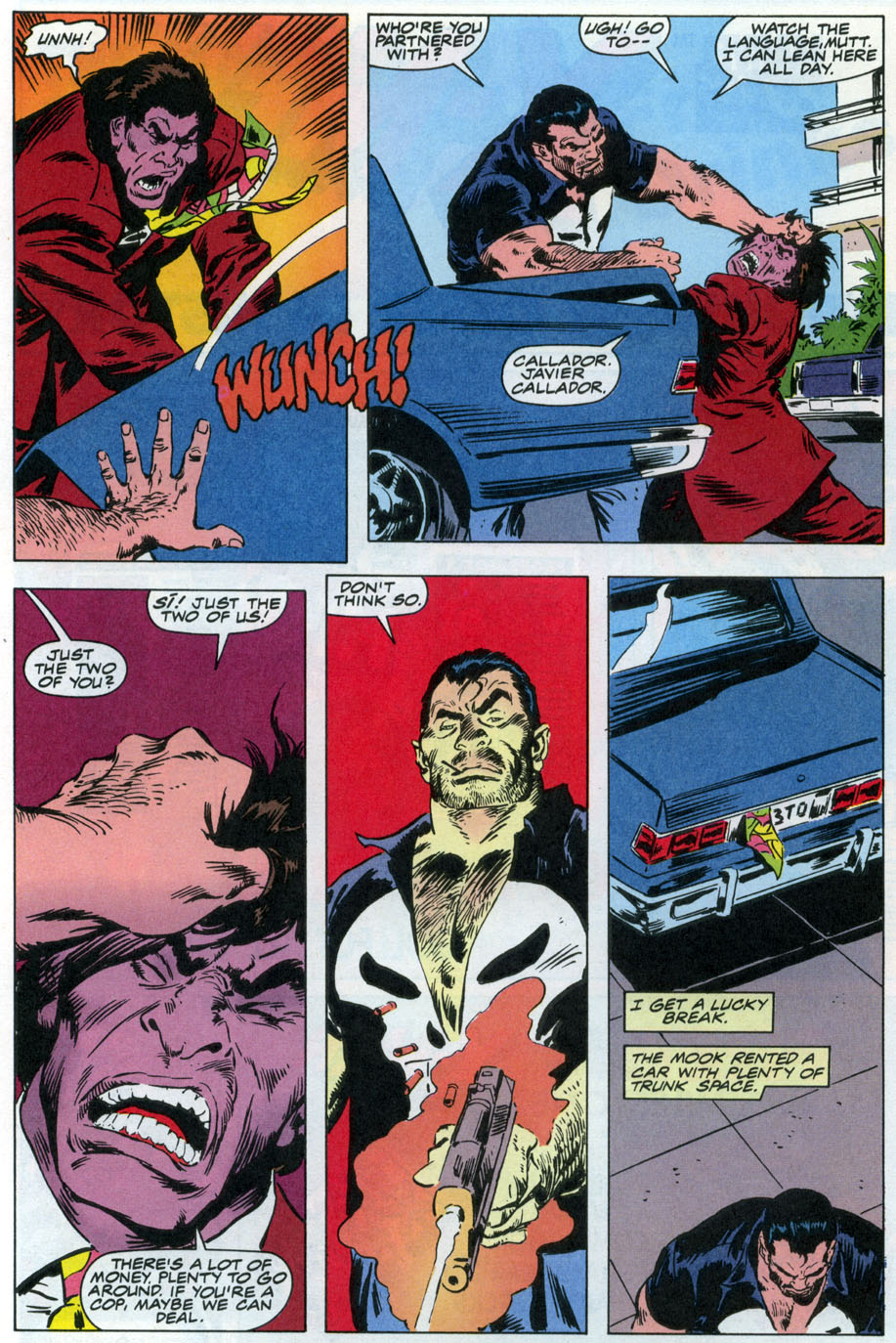 The Punisher War Zone #26
The Punisher War Zone #26
It’s hard to overstate how popular the Punisher was in the early 1990s. At one point, he had three simultaneous ongoing series: The Punisher, The Punisher War Journal, and The Punisher War Zone. Then there were the yearly Holiday Special (my all-time favorites), Summer Special, and Back to School Special, plus several one-shots, plus a semi-regular series devoted to Frank’s weapons called The Punisher Armory. That’s right, there was a time when Marvel targeted kids with comics that consisted entirely of pin-ups detailing the killing power of various weapons!
Ultimately, your enjoyment of the Punisher’s escapades hinges on how seriously you are willing to take their moral implications. Some readers just dig the exhilaration and catharsis. Others, worryingly, may find themselves regarding the series’ hero with a measure of understanding or even admiration. Others will no doubt object, not only to the celebration of macho violence, but to the comics’ problematic racial dimension.
I would argue that some writers got away with it by keeping their comics on the border between actually embracing the Punisher’s quasi-fascist values and merely entertaining readers with his high-octane exploits. Notably, there was a streak of dark humor running through many of these issues. For example, capping stories with dry punchlines was a common move used by Steven Grant (‘Red Christmas,’ ‘Last Confession,’ ‘Bodies of Evidence’), Mike Baron (‘The Spider,’ ‘Bad Tip,’ ‘Confession’), and Chuck Dixon (‘Slay Ride,’ ‘Good Money After Bad,’ ‘Ten-To-One’).
The covers were quite tongue-in-cheek as well. They featured a menacing-looking Punisher, yet superimposed hilariously cheesy tag lines like ‘Every year, Hawaiian vacations end safely and happily for more than a million people. They aren’t in this issue.’ or ‘Summertime… and the living ain’t easy… but dying is… in the killing fields!’
Still, despite the awesome covers, the ’90s Punisher comics weren’t treated as *primarily* comedic. But that was about to change…
NEXT: More Punisher.


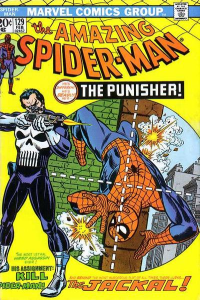
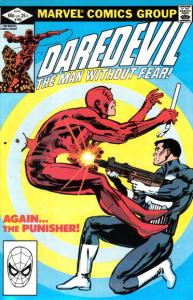
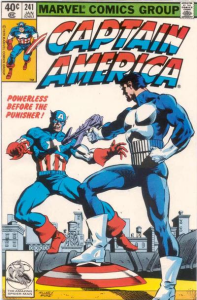
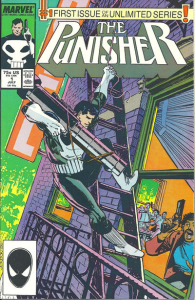
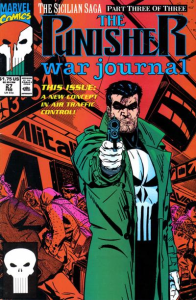
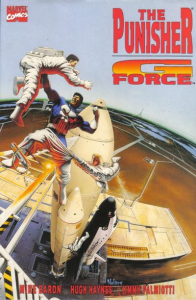
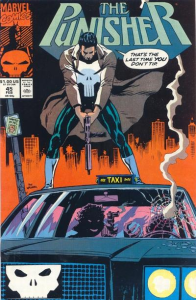
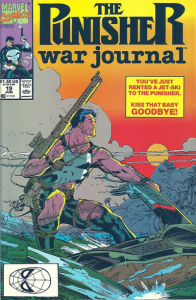
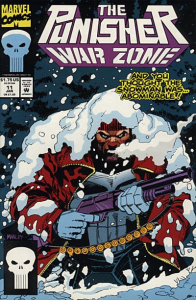
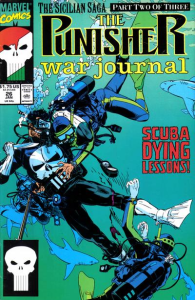
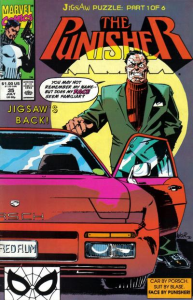
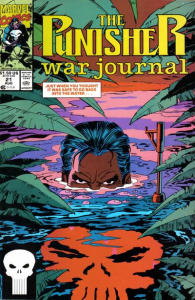
Can see a mile off that Deadly Knights clip is JRjr’s work. Has Romita junior ever done a LoDK or similar series; or a story arc in Batman or ‘Tec?
Interesting too that the climate which gave birth to the Punisher’s origin – post-hippie comedown of violent 70s exploitation & vigilante combaters of crime – also led ‘over the pond’ to the likes of 2000AD’s Judge Dredd, via Dredd ancestors in British comics like One Eyed Jack (in Valiant: an Eastwoodian urban, NYPD I believe, cop written by Dredd creator John Wagner) and Dredger (dirty British intelligence agent in legendary banned title Action).
Romita Jr did the first arc of All Star Batman a few years ago, which looked quite nice. I know he recently did some stuff for Batman’s main title as well, but I’m not caught up on that… As for Dredd and his predecessors, I’m actually a bigger fan of them than I am of the Punisher and I hope to write about them soon! (Although my favorite Valiant strip will always be Steel Claw…)